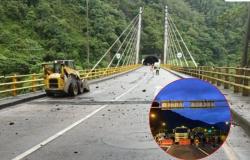
Javascript is disabled in your web browser.
Please, to view this site correctly,
enable javascript.
For instructions to enable javascript
In your browser, click here.
Two years ago, Myriam Fliman came to head the board of directors of the Port of Antofagasta, at which time the commercial engineer – along with the rest of the members of that board – began to consider possible investment projects.
This is how the leadership of the state company focused on an ambitious project: the expansion of the Port of Antofagasta. In this regard, Fliman explained that this plan – whose investment amount is around US$ 53 million – has three main stages, which begin with the expansion of the Portezuelo Antepuerto, continues with the urbanization of the port and ends with a large expansion of the port. shelter that protects the enclosure.
“We began little by little to define the priorities and paths to follow. There were many investment projects, but we realized that there was one that was a priority, since we sought to provide the country and the region with an increase in port logistics capacity, which is something that is needed,” stated the director.
“2023 was one of the best years of the last decade, and we hope 2024 will be similar. So, we need to expand to be able to contain the growing demand.”
“Climate change has led to rising sea levels and we have to prepare.”
– What prompted you to carry out the expansion of the port?
– 2023 was one of the best years of the last decade, and we hope that 2024 will be similar. So, we need to expand to be able to contain the growing demand. Added to this are the effects of climate change, with respect to which we are facing a quite complex panorama, since it has led to the rise in sea level, and we have to prepare for these phenomena. We are anticipating what will continue to come. Many companies are doing it, and it’s difficult if we don’t take action like everyone else.
– In detail, what is this extension about?
– This is a Master Plan in three stages. The first was to improve and expand the Portezuelo Anteport, which doubled its loading capacity, which was inaugurated last week and will allow the storage capacity of the facilities to be increased by up to 50% in tons per year. Secondly, we have a 40-hectare plot of land in the La Negra area, 20 kilometers from the city, where we began urbanization works to increase support areas and spaces for SMEs to settle, in addition to a rest area for trucks. And the third project, which is the most ambitious and attractive, is the increase of the port’s shelter by 85 meters.
– When do you expect to have the three stages ready?
-The first stage has already been delivered, and we hope that the urbanization phase, which is already in process, will be ready by the end of the year. Regarding the shelter, we have already started with the engineering studies and it is likely that we will be able to start work in the middle or end of next year.
– Both the expansion of the port of Valparaíso and that of San Antonio have had problems with the community. How have you approached that challenge?
– We haven’t had any problems at all. Even, we have already passed all the environmental issues. We want to contribute to combating climate change, and we are a port very aware of its role with the city and the region. We have a very lively port and different activities take place on our site. So, all our considerations are understanding that we have a role; We are not an isolated port that can do what it wants, when and where it wants.
– Another issue that has been echoed in the ports is the strikes of workers due to working conditions. How do you see these processes?
– We have concessioned the loading and unloading process to a company, they are the ones who have the port workers. Of course we are on top of the issue and we are interested, the ideal is for workers to be in the best possible conditions.
International relations
-How is the relationship with Bolivia?
– We are in excellent relations, we continue to comply with the Treaty of Peace and Friendship of 1904, at full speed. In fact, it was Bolivian businessmen who made the investment in Portezuelo, because they trust this corridor and us.
-And the relationship with the other nations in the region?
– Excellent. For example, in La Negra we are going to have a Paraguayan Free Zone to comply with the treaties with that country. Furthermore, we are very immersed in the issue of the Bioceanic Corridor, we have sent delegations and we are participating with the authorities, the regional governor, etc. And with the expansion, the port of Antofagasta will be one of the most important ports in the Bioceanic Corridor. So, we want to continue to push this forward.
– Could the decision to increase safeguards for Chinese steel balls affect you?
– There may be a drop, but not in a very significant amount. Of all our loading and unloading, this is a minor percentage. Things are adjusting, we are opening new markets, among other things, and today we are quite diversified. Even though it is mining, I don’t think we will have a major problem with it.





